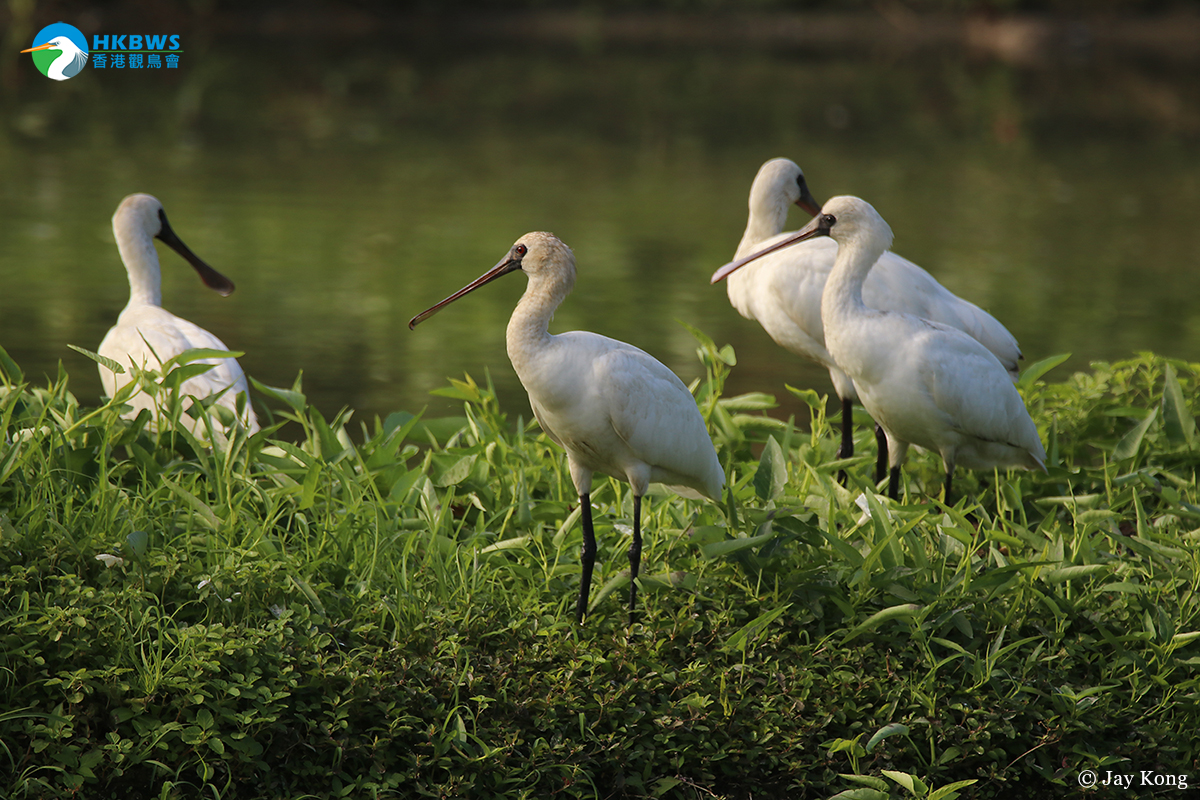|
waiting
- UID
- 15265
- Posts
- 42
- Digest
- 0
- Credits
- 0
- NickName
-
- Online
- 79 hours
- Registered
- 23/07/2021
- Last login
- 24/04/2023
|
1#
A A
A Post at 1/04/2022 18:59 Show author
黑臉琵鷺全球同步普查2022 International BFS Census 2022
黑臉琵鷺全球數量首破六千再創新高
后海灣數量稍回升 數字趨平穩
由香港觀鳥會統籌的「黑臉琵鷺全球同步普查2022」已於1月7至9日完成。本年度黑臉琵鷺全球數量達6,162隻,再創有記錄以來新高,較去年上升18%,增加了940隻。后海灣(包括香港及深圳)錄得369隻,按年上升9.8%,數字與過去幾年相距不大,趨於平穩。


黑臉琵鷺全球數量續升 十年九度刷新紀錄
本年度普查覆蓋全球約150個地點,除了澳門及菲律賓,其餘度冬地的黑臉琵鷺數量均有增長。台灣繼續是最主要棲息地,全球逾62%、即3,824隻黑臉琵鷺在該處度冬,按年升幅為22.1%;日本亦上升19.8%,錄得683隻。兩地黑臉琵鷺大增,加上后海灣以及中國大陸的數量回升,令全球黑臉琵鷺數目得以首次突破6,000隻,亦是過去10年來,第9次錄得破紀錄新高。值得一提的是,馬來西亞今年錄得兩隻黑臉琵鷺,是1994年首屆普查以來的南方新記錄,反映黑臉琵鷺於東南亞棲地範圍廣大。
在港數量止跌回升 全球佔比續跌
后海灣黑臉琵鷺數量連跌兩年後回升至369隻,較去年多33隻,米埔自然保護區和香港濕地公園錄得的黑臉琵鷺總和增加,兩處地方均實施生態環境管理,為黑臉琵鷺提供合適棲息地。香港觀鳥會總監余日東提醒,后海灣普查結果雖有增長,但升幅不算顯著,不能因而斷定生態環境有所改善。他表示:「香港的數字上升,某程度上要歸功於全球種群增加,有更多黑臉琵鷺選擇在本港越冬停歇。」
不到20年前,香港曾是全球五分一黑臉琵鷺的度冬地。然而,后海灣自2010年錄得歷屆普查最多的462隻黑臉琵鷺後,多年來未見突破,2016年起一直維持於300多隻的水平;與此同時,全球數量則穩步上升,台灣、中國大陸及日本的數字近年屢刷新紀錄。時至今日,后海灣只佔全球黑臉琵鷺數目約6%。
后海灣保育前景 取決北部都會區規劃
要吸引更多黑臉琵鷺來港棲息,關鍵在於保存后海灣濕地生態系統的完整性,本會期望《北部都會區發展策略》建議設立的三個濕地保育公園,可成為保育契機。余日東強調,濕地保育公園須符合三大基本條件:範圍廣闊、生態友善及減少人為干擾,「不能只是『公園仔』,地方要夠大,要有充足食物來源。」
余日東建議,將國際鳥盟確認的重點鳥區「內后海灣及深圳河集水區」納入濕地保育公園範圍,甚或提升至《野生動物保護條例》下的限制地區,制訂長遠保育方案及生境管理措施,保育白泥至馬草壟一帶的魚塘、泥灘、沿海濕地等多元化生境。潮間帶泥灘及魚塘濕地向來是黑臉琵鷺及候鳥重要覓食地,政府收地前後都應以生態友善方式維持運作,例如收成後降低魚塘水位讓水鳥捕食雜魚小蝦,發揮其生態價值。濕地保育公園落成開放後,必須劃設禁區,保護黑臉琵鷺棲息及覓食地免受人為干擾。最後,本會再次促請政府妥善規劃濕地保育公園,制訂收地時間表,擴大自然保護區範圍,保護后海灣生態。
Black-faced Spoonbill population hits record high of 6,000
Slight rebound in Deep Bay reflects population levelling off
Coordinated by The Hong Kong Bird Watching Society (HKBWS), The International Black-faced Spoonbill Census 2022 was conducted from 7th to 9th January. Global population of Black-faced Spoonbills (BFSs) reaches another record high of 6,162, a rise of 18% (i.e. 940 individuals) from last year. 369 individuals were recorded in Deep Bay, including Hong Kong and Shenzhen side. While the figure shows a rebound of 9.8%, it has become stabilized and does not differ fundamentally from those of previous years.
BFS global population breaks record for 9th time in decade
The 2022 census covered about 150 sites all over the world. All wintering sites, except for Macau and the Philippines, reported growing BFS populations. Taiwan remains the largest congregation site. Number of BFSs recorded there increases by 22.1% to reach 3,824, constituting 62% of the world population. Japan, too, is seeing a surge of 19.8% and recorded 683 individuals. With rebounding numbers in both Deep Bay and mainland China, promising signs from all major wintering sites help boost global BFS population to surpass 6,000 for the first time, making 2022 the 9th recording-breaking year over the past decade. Besides, we are delighted to have two individuals wintering in Malaysia, a new southern record since the census was first launched in 1994. New sightings suggest the BFSs may disperse over a large area in Southeast Asian region to roost.
Hong Kong population recovers, with declining share of global total
After two consecutive years in decline, Deep Bay BFS population gains 33 individuals this year and bounces back to 369. More BFSs were recorded in the Mai Po Nature Reserve and the Hong Kong Wetland Park, where habitat management measures are in place to provide suitable roosting sites for them. Mr. Yu Yat-tung, Director of HKBWS, noted that a mild growth was insufficient to determine whether habitats in Deep Bay have been restored. "Rising numbers in Hong Kong is largely attributed to surging global population, as more BFSs stopped over in Hong Kong and spent the winter here."
Less than two decades ago, Hong Kong was the winter home to one-fifth of BFS population worldwide. However, ever since Deep Bay population reached an all-time high of 462 individuals in 2010, its growth has stalled and the number has been hovering around 300 since 2016. Meanwhile, global figure continues to pick up steadily. Populations in Taiwan, mainland China and Japan keep hitting new record highs. At present, BFSs in Deep Bay constitutes only 6% of the global total.
Prospects of Deep Bay conservation hinges on the Northern Metropolis
Keeping wetland ecosystem in Deep Way intact is a prerequisite for attracting more BFSs during fall migration. The three Wetland Conservation Parks proposed under the Northern Metropolis Development Strategy can bring opportunities for conservation. Yu stressed that the Parks have to be spacious, eco-friendly with minimal human disturbance. "The Parks cannot be small. They must be large enough to provide abundant food supply for the BFSs."
Yu suggested that the "Inner Deep Bay and Shenzhen River catchment area", an Important Bird Area recognized by BirdLife International, be included in the Wetland Conservation Parks or designated as a restricted area under the Wild Animal Protection Ordinance. Long term conservation plans and habitat management measures are needed to preserve fishponds, mudflats and coastal wetlands in areas from Pak Nai to Ma Tso Lung. Feeding grounds for migratory birds including intertidal mudflats and fishponds should remain active both before and after government’s land resumption. Eco-friendly measures should remain in place, e.g. draining fishponds after harvest to let waterbirds feed on trash fish left on the muddy pond bottom. Finally, restricted areas should be delineated in the Wetland Conservation Parks to protect BFSs from human disturbance. For the sake of preserving Deep Bay's biodiversity, HKBWS again calls on government to make proper planning, set out a land resumption timetable for conservation and expand the nature reserve.
|


